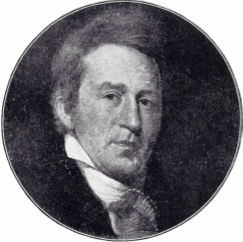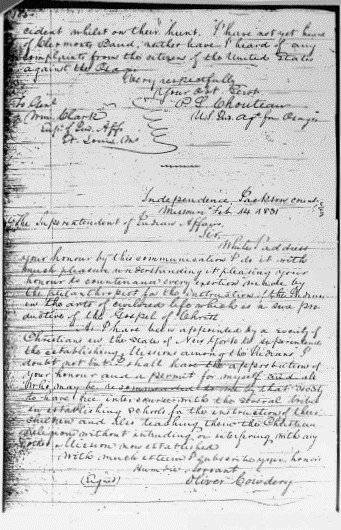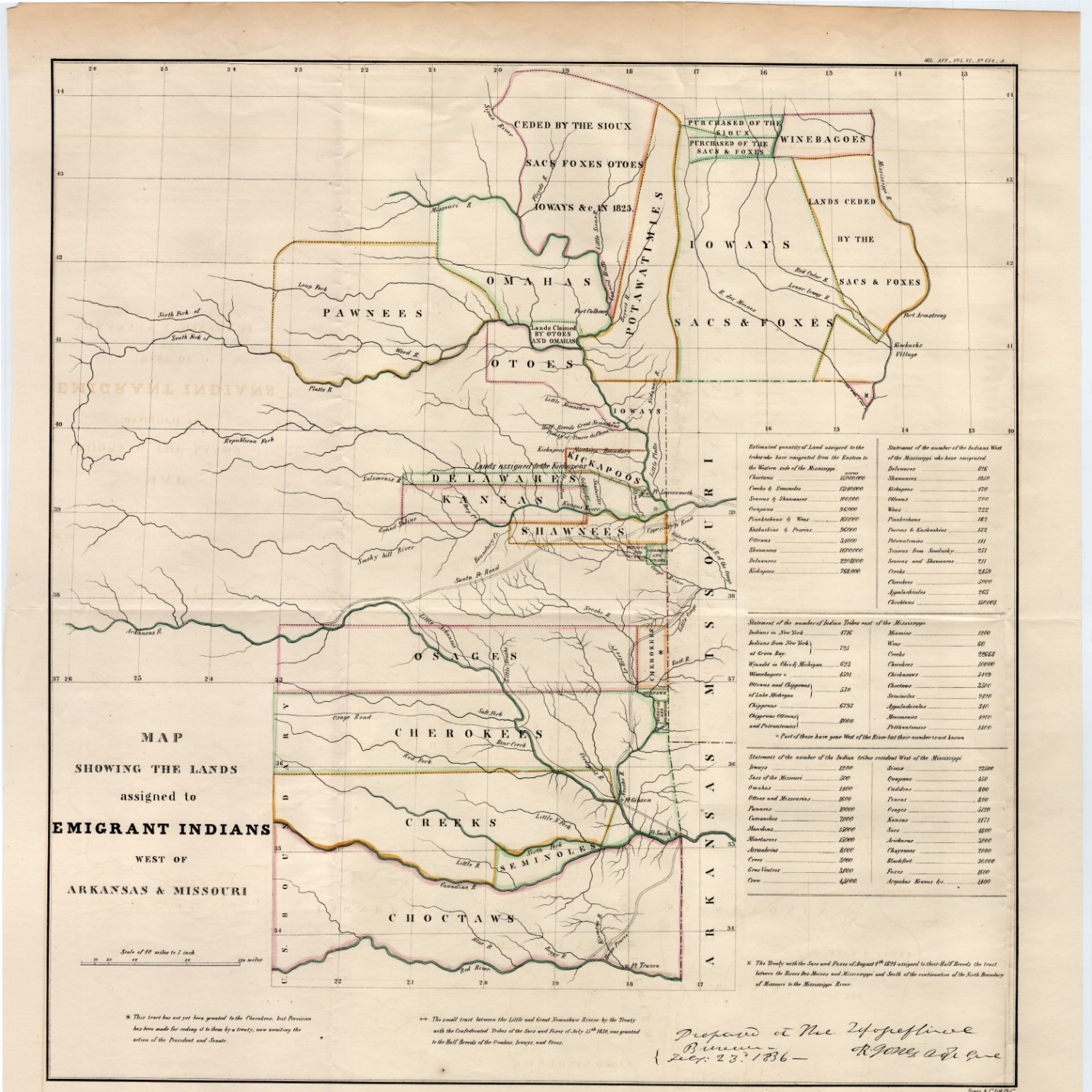Oliver Cowdery’s Letter to Indian Superintendent William Clark
The Bank of Missouri had been created by the legislature on Dec. 17, 1816 with Auguste Chouteau, president and an enterprising young man, Lilburn Boggs as cashier[i]. A youthful Boggs was introduced to the aristocracy of St. Louis, namely Auguste Chouteau, William Clark and Thomas Benton and their friends. Initially, the Bank of Missouri was relatively stable due to conservative lending practices and because it had the benefit of being the Far Western depository for United States Government funds. The following year Benton was elected by fellow stockholders to the Board of Directors of the Bank of Missouri.[ii]
John Jacob Astor arranged for two expeditions to support the development of Astoria on the Pacific Coast; one by sea and one overland. On the return trek of the overland party to escape from warring Indians they unexpectedly found a secret passage trail through the Rocky Mountains in November 1812. The Missouri Fur Company was formed by Chouteau, Clark and others earlier in February. It was later their intentions to expand the fur trade westward through the Rocky Mountains. and exploit the secret of South Pass.
The town of Independence was formed in 1827 with an alliance of merchants engaged in the trade with Indians and trappers along the upper Missouri River and the Platte Rivers, also the merchant caravans to Santa Fe. Due to the Indian Relocation Act of 1830 many eastern tribes were transplanted near the Jackson County border thereby broadening the merchant trade base.
During September 1830 Joseph Smith called Oliver Cowdery and others to serve a mission to the Indians at the site of “the borders of the Lamanites.” (D&C 28:9)
Oliver Cowdery, Peter Whitmer Jr., Ziba Peterson, and Parley P. Pratt were huddled in an Indian lodge on the plains of Kansas Territory waiting for their turn to speak. They were surrounded by forty tribal leaders of the Delaware Nation. The chief motioned for them to address the gathering. Elder Cowdery arose and testified from his heart,
“Thousands of moons ago, when the red men’s forefathers dwelt in peace and possessed this whole land, the Great Spirit talked with them, and revealed His law and His will, and much knowledge to their wise men and prophets.”
Elder Cowdery continued his message to this captive audience indicating that the Book of Mormon contained the history and prophecies of the “things which should befall their children in the latter days.” He promised if they would follow the teachings of the Book of Mormon, the “Great Father” would assist them to prosperity and a return to their former greatness. Chief Anderson appreciated their heart-felt messages and replied: “It makes us glad in here” while placing his hand over his heart. The concerned Chief continued:
“It is now winter, we are new settlers in this place; the snow is deep, our cattle and horses are dying, our wigwams are poor; we have much to do in the spring- to build houses, and fence and make farms; but we will build a council house, and meet together, and you shall read to us and teach us more concerning the Book of our fathers and the will of the Great Spirit.”[iii]
The elders continued teaching and several of the Indians were desirous to learn more. Copies of the Book of Mormon were distributed and gratefully received. When news of their preaching became to government leaders, they were ordered to leave until they had permission from General William Clark, Superintendent of Indian Affairs in St. Louis, to return.
Heeding their instructions, Elder Cowdery wrote to General Clark on February 14, 1831. In the letter, Elder Cowdery reported it was their intent to establish schools for the Indians as others were, but would not interfere with any other Mission established to teach the Indians.
 Promptly, the local Indian Agent, Richard Cummins in Jackson County, wrote to Superintendent William Clark of the Mormon request:
Promptly, the local Indian Agent, Richard Cummins in Jackson County, wrote to Superintendent William Clark of the Mormon request:
“They say they are sent by god and must preach, they have a new Revelation with them, as (their) guide in teaching the Indians, which they say was shown to one of their sect in a miraculous way, and that an angel from heaven appeared to one of their men and two others of their sect, and showed them that the work was from God and much more etc. I have refused to let them stay, or, go among the Indians unless they first obtain permission from you.”[iv]
Superintendent William Clark apparently chose not to reply to their request.[v] A capable administrator, Clark simply filed the two letters he had received from Cowdery and Cummins.
The Indian Agent, Richard Cummins joined with Lilburn Boggs, Samuel Owens, and others in an association named the “Secret Constitution”. They became fearful of Mormon intrusion into their trade monopoly pursuits on the Santa Fe Trail and the Upper Missouri and Platte River regions. The old settlers were opposed to the Moromon’s religious beliefs, cultural differences and political strengths.
On July 30, 1833 the manifesto including the drafts of mid July were presented to the Mormons of Jackson County beginning with:
“We, the undersigned, citizens of Jackson County, believing that an important crisis is at hand, as regards our civil society, in consequence of a pretended religious sect of people that have settled, and are still settling in our county, styling themselves ‘Mormons’; and intending, as we do, to rid our society, peacefully if we can, forcibly if we must,’ and believing as we do, that the arm of the civil law does not afford us a guarantee, or at least a sufficient one, against the evils which are now inflicted upon us; and soon to be increasing, by the said religious sect, deem it expedient, and of the highest importance, to form ourselves into a company for the better and easier accomplishment of our purpose-a purpose which we deem it almost superfluous to say, is justified as well by the law of nature, as by the law of self-preservation.”[vi]
After mob violence commenced, they destroyed the printing press of William W. Phelps and the church store managed by Sydney Gilbert. In the August 1832 issue of the Evening and Morning Star, William Phelps printed an article regarding “Excerpts from the Enoch Prophecy”. Two years later a passer by Louis Cortambert, verified the real reason the Saints were forced from Jackson County:
. The Mormons are a religious sect who were also impelled by some instinct or other to go to the West. They cast their eyes on the country around Independence, the New Jerusalem. Several articles of their doctrine, notably the abolition of slavery, tended to turn the settlers against them. But what gave the finishing touch to irritating the almost completely mercantile population of Independence was this: the Mormons, wishing to devote themselves to commerce and at the same time to agriculture, had brought in a considerable quantity of merchandise; since they were in need of country produce for their subsistence, they offered the neighboring farmers their merchandise in exchange, in place of money. The farmers, finding the merchandise of good quality and cheap, turned to the Mormons, and the other shops were neglected. Hence a general market town insurrection against the new sectarians. A political coloration was given to the affair, and the Jacksonians, or Democrats, who are in the great majority in Jackson County, of which Independence is the county seat, organized a regular persecution of the Mormons. These unfortunate people were besieged in their houses, basely mistreated, and finally turned out.[vii]
The original of Cowdery’s letter to William Clark is at the Church History Library. This map illustrates the magnitude of the future Indian trade and Santa Fe commerce for Jackson County merchants. Due to the Law of Consecration, they couldn’t compete with the Mormons.
 [i] Robert Nelson, Enemy of the Saints (Baltimore: Publishamerica, LLLP, 2011), 44
[i] Robert Nelson, Enemy of the Saints (Baltimore: Publishamerica, LLLP, 2011), 44
[ii]William Nisbet Chambers, Old Bullion Benton (Boston: Atlantic Monthly Press, 1956), 90
[iii] Parley P. Pratt, Autobiography of Parley Parker Pratt, (New York: Russell Brothers, 1874), 42-44
[iv] Jay H. Buckley, William Clark Indian Diplomat (Norman: University of Oklahoma Press, 2008), 221,223
[v] Church Education System, Church History in the Fullness of Times Student Manual (Salt Lake City: Church of Jesus Christ of Latter Day Saints, 2003),.86-88 Copy of letter from Oliver Cowdery to William Clark Feb 14, 1831 in William Clark letter book
[vi] Robert Nelson, Enemy of the Saints (Baltimore: Publishamerica, LLLP, 2011), 68
[vii] Louis Cortambert, The Bulletin: Missouri Historical Society April 1963, 207 -209. From the contemporary account given by the Frenchman Louis Cortambert in his article, “Journey to the Land of the Osages 1835-1836”.
I seriously love your site.. Very nice colors & theme.
Did you build this website yourself? Please reply back
as I’m looking to create my own blog and want to find out where you got
this from or what the theme is called. Thanks!
Спасибо, давно искал
_________________
снятие средств в олимпе бк
http://qpgps.ru
investigate this site darknet
В наше время, кальян является не просто модным девайсом, но и средством приятного времяпровождения с компании друзей.
Однако для не опытного человека может возникнуть ряд трудностей при выборе как кальяна, так и табака, однако речь идет не только о разнообразии вкусов, но и крепости.
Подобрать табак самостоятельно, Вам поможет данная статья. Она подскажет какую крепость выбрать и как подобрать качественный товар.
В первую очередь, Вам нужно знать то, что все табачные смеси для забивания кальяна, изготовлены примерно из идентичных табачных листов.
купить табак для кальяна недорого
В состав каждой смеси входят такие компоненты как :
1. глицерин
2. патока
3. мед или сахарный сироп
4. ароматизаторы
5. и самое главный компонент – табачный лист.
Именно различие последнего и самого важного компонента поможет Вам разобраться и ориентироваться в вариациях табака.
Всего в мире насчитывается около 60 вариантов табака, однако при производстве кальянной смеси используют только 4 вида:
1. Вирджиния голд – самый популярный вид табака. В то же время он является лучшим для людей, которые только начинают свое знакомство с кальяном. Данный табак не слишком крепкий и он имеет характерный сладковатый привкус, благодаря этим особенностям, при курении кальян будет легким, а смесь будет иметь более яркий и приятный вкус.
2. Ориентал – Данный табак подойдет людям, которые хотят меньшее содержание никотина. Данный табак используют для приготовления самых мягких кальянов.
3. Берли – данный табак не так популярен, как предыдущие и он так же реже встречается на прилавках магазина. Он не подойдет для новичка, однако для более опытных в самый раз. Этот табак имеет значительное преимущество над всеми разновидностями табака – он достаточно крепок и прекрасно впитывает и передает во время курения насыщенный аромат и вкус.
4. Мэриленд – средний крепости табак американского производства. Имеет приятные вкусовые качества.
первоклассный вебсайт
Короткие интим истории про анал
Guys just made a site for me, look at the link:
https://www.google.com/url?sa=t&url=http%3A%2F%2Fp7405608.ru/kak-ukrasit-svoj-dom-interesnymi-funkczionalnymi-elementami Tell me your recommendations. Thanks.
Guys just made a website for me, look at the link:
https://topideya.io.ua/ Tell me your references. Thanks!
check my blog empire market url
Hi, all is going sound here and ofcourse every one is sharing facts, that’s in fact good, keep up writing. https://vanzari-parbrize.ro/parbrize/parbrize-jaguar.html
visit their website https://hydramirror2020.com
добросердечный веб ресурс
Интимные фото голых девок на природе
ВАЙТПАК
Мы изготовим для Вас техническую упаковку, мешки для бытового, строительного, хозяйственного мусора и различных отходов. Своим клиентам предлагаем качественную продукцию, по европейским стандартам и санитарно-гигиеническим нормам. Работаем с проверенным и безопасным сырьем.
https://www.white-pack.ru
12 шагов где пройти – лечение алкоголизма в ребцентре, принудительное лечение от алкоголя
redirected here гидра
Hello! lasix online purchase purchase lasix online
go right here darknet
аккаунт в яндекс директ – купон яндекс директ 3000 7000, яндекс директ промокод 3000
navigate here empire market reddit
курсы подготовки к егэ спб – профориентация для школьников, подготовка к егэ по физик
Wow, superb blog layout! How long have you been blogging
for? you made blogging look easy. The overall lokk of your site
is excellent.Thanks a lot for the informative and well-researched content.
my site: judi sabung ayam
check out this site https://hydramirror2020.com